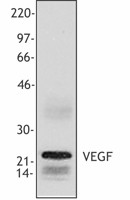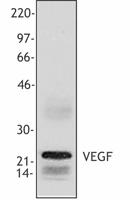- Clone
- Poly6275 (See other available formats)
- Regulatory Status
- RUO
- Other Names
- Vascular endothelial growth factor, vasculotropin, vascular permeability factor
- Isotype
- Rabbit Polyclonal IgG
- Ave. Rating
- Submit a Review
- Product Citations
- publications

-

Human recombinant VEGF 165 produced in yeast was resolved by electrophoresis, transferred to nitrocellulose and probed with rabbit anti-VEGF polyclonal antibody. Proteins were visualized using a donkey anti-rabbit secondary conjugated to HRP and a chemiluminescence detection system. This antibody detects reduced VEGF consistent with the molecular weight shown (approximately 22-24 kD) as well as unreduced VEGF (data not shown).
| Cat # | Size | Price | Quantity Check Availability | Save | ||
|---|---|---|---|---|---|---|
| 627501 | 50 µl (5 Western blots) | 95€ | ||||
VEGF, also known as vascular endothelial growth factor, vasculotropin, and vascular permeability factor, is a widely expressed mitogen for vascular endothelial cells that has been shown to promote angiogenesis and increase permeability of capillary blood vessels. VEGF is a member of the platelet-derived growth factor (PDGF) family and is produced as a homodimeric protein with approximate molecular weights of 34-46 kD. The variance in molecular weight is a result of alternative splicing events that encode monomeric proteins having 121, 165, 189 or 206 amino acids. VEGF121 and VEGF165 are secreted proteins whereas VEGF189 and VEGF206 are strongly cell-associated. VEGF binds to VEGF-R1 (also known as Flt-1) and VEGF-R2 (also known as KDR). Inhibition of VEGF biding to VEGF-Rs has been the focus of a number of tumor therapeutic strategies. The Poly6275 antibody recognizes the N-terminal region of human VEGF has been shown to be useful for Western blotting of both reduced and non-reduced VEGF.
Product DetailsProduct Details
- Verified Reactivity
- Human
- Antibody Type
- Polyclonal
- Host Species
- Rabbit
- Immunogen
- Peptide mapping to a domain near the N-terminus
- Formulation
-
This antibody is provided in phosphate-buffered solution, pH 7.2, containing 0.09% sodium azide and 0.2% gelatin.
Previous lots of this product may have been formulated with 0.1% or 0.05% NaN3 instead of 0.09% NaN3. For further information please contact BioLegend Technical Support or Customer Service. - Preparation
- The antibody was purified by antigen-affinity chromatography.
- Concentration
- Lot-specific (to obtain lot-specific concentration and expiration, please enter the lot number in our Certificate of Analysis online tool.)
- Storage & Handling
- Upon receipt, store undiluted between 2°C and 8°C.
- Application
-
WB - Quality tested
- Recommended Usage
-
Each lot of this antibody is quality control tested by Western blotting. Western blotting, suggested working dilution(s): Use 10 µl per 5 ml antibody dilution buffer for each mini-gel. It is recommended that the reagent be titrated for optimal performance for each application.
- Application Notes
-
This product may contain other non-IgG subtypes. - Product Citations
-
- RRID
-
AB_2272658 (BioLegend Cat. No. 627501)
Antigen Details
- Structure
- Contains 8 cysteine residues involved in intra- and inter-chain disulfide bonds, platelet-derived growth factor (PDGF) family, produced as a homodimeric protein with an approximate molecular weight of 34-46 kD. Human VEGF is alternatively spliced to encod
- Distribution
-
Widely expressed
- Function
- Mitogen for vascular endothelial cells, promotes angiogenesis and increases permeability of capillary blood vessels
- Interaction
- Heparin, many other proteins
- Ligand/Receptor
- VEGF-R1 (Flt-1) and VEGF-R2 (KDR)
- Modification
- Glycosylation
- Biology Area
- Cell Biology, Immunology
- Molecular Family
- Cytokines/Chemokines, Growth Factors
- Antigen References
-
1. Connolly DT, et al. 1989. J. Clin. Invest. 84:1470.
2. Drake CJ, et al. 1995. Proc. Natl. Acad. Sci. USA 92:7657.
3. Houck KA, et al. 1991. Mol. Endocrinol. 5:1806. - Gene ID
- 7422 View all products for this Gene ID
- UniProt
- View information about VEGF on UniProt.org
Related FAQs
Other Formats
View All VEGF Reagents Request Custom Conjugation| Description | Clone | Applications |
|---|---|---|
| Purified anti-VEGF | Poly6275 | WB |
Compare Data Across All Formats
This data display is provided for general comparisons between formats.
Your actual data may vary due to variations in samples, target cells, instruments and their settings, staining conditions, and other factors.
If you need assistance with selecting the best format contact our expert technical support team.
-
Purified anti-VEGF

Human recombinant VEGF 165 produced in yeast was resolved by...
 Login / Register
Login / Register 







Follow Us